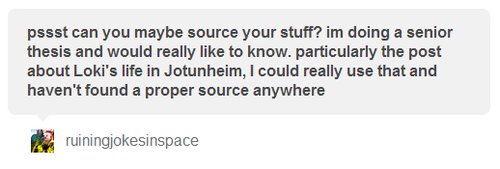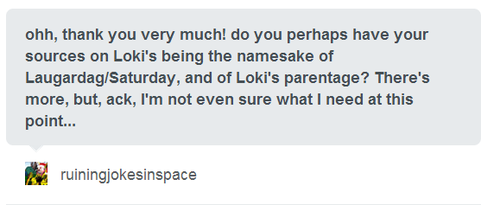#farbauti

Of course! I hope this is a good way to do it - I’m not very tumblr-savvy…

I’ve been meaning to start sourcing everything, but it will probably take a bit of time, since a lot of the information is just kind of my accumulated knowledge (I’ll do my best though!). About Loki’s life in Jotunheim specifically, let me see… I know the first time I read about it was in The Norse Myths by Helena Yvette Grimes, but that book is not really an academic one, and it’s very inaccurate in some parts. This website’s (http://shadowlight.gydja.com/loki.html) info on the subject is accurate and well-written, but this website is not academic either. Myths of the Norsemen by H.A. Guerber, an academic text, touches on Glut, Eisa, and Einmyria in chapter 22 (http://free.sbooks.net/H_A_Guerber/Myths_of_the_Norsemen/kindle.html), but not in exceptional detail. From a cursory sweep of my sources that I expected to have the right information, that is what I’ve found. Let me know if you want me to find more sources. I know there ARE more, but I’d have to reread a lot of material to locate the others. I definitely don’t mind doing this, since I should have been citing my sources from the beginning. Also, it’s always good to refresh knowledge. So just let me know if you’d like me to dig a little deeper. Thanks for bearing with me!

I’m so sorry for not responding sooner! The Laugardag/Saturday is also primarily from H.A. Guerber’s Myths of the Norsemen. Loki’s parentage is a bit trickier, because nearly every piece about Loki will mention Loki’s parentage, but they all say different things. It’s because no one is quite in agreement on Loki’s true origins. For that reason, what I’ve posted here might not even be the most accurate answer.
The H.A. Guerber text cites the three different possibilities of Loki’s parentage, in chapter 22 like the information on Eisa, Einmyria, and Glut. [1]One possibility is that Loki was among the family of original gods with Odin and Hoenir, since the three make up a common triad. There is also the possibility that Loki was:
“[2]the son of the great giant Fornjotnr (Ymir), his brothers being Kari (air) and Hler (water), and his sister Ran, the terrible goddess of the sea. Other mythologists, however, make him [3]the son of the giant Farbauti, who has been identified with Bergelmir, the sole survivor of the deluge, and of Laufeia (leafy isle) or Nal (vessel), his mother” (Guerber).
I’m sorry to keep suggesting the Guerber text, but many other mainstream texts are painfully inaccurate (with respect to older sources and artefacts) and suffer from some form of factual distortion. This is one of the few that doesn’t, so it’s a good source of information.
This (http://shadowlight.gydja.com/loki.html) well-informed/written but non-academic site that I’ve suggested before details Loki’s descent from Farbauti and Laufey.
I’m fairly certain that Rudolf Simek’s Dictionary of Norse Mythology provides a good explanation on Loki’s parentage, but I don’t know on which page it is.
Otherwise, you can always use more original sources, like Snorri’s Prose Edda Gylfaginning, in which it is explicitly stated that Farbauti and Laufey are Loki’s father and mother. It also describes their escape from the flood. The Prose Edda Skaldskaparmal calls Loki “son of Farbauti and Laufey”, “Farbauti’s son”, and “Farbauti’s sly son”.
I owe you a lot more sources than this, but I study this field for leisure only, so I haven’t kept very good record of my sources. I am currently going through all texts/research papers/articles/websites I have saved up, so that I can properly document everything on here (It may take a while though). Until then, I hope this will do!
In the Norse creation mythology, the worlds were created mainly through the clashing of fire and ice, heat and moisture. Among the first beings in existence were the fire giant/deity Surtr, the hrimthurs (ice giant/deity) Ymir, and the giant nourishing cow Audhumla. From heat and moisture on his body, Ymir begat other beings, and they in turn produced their own offspring. Odin was closely descended from Ymir on his mother’s side, and Odin’s paternal grandfather, Buri, was considered the first god. Buri had been different from Ymir’s creations in that he had been created from the cow Audhumla’s licking of a block of ice (creation was again achieved through a meeting of heat and ice).

Odin and his immediate family, although partially descended from Ymir, considered themselves set apart from Ymir’s creations, dubbed the Jotnar. Odin and his brothers saw Ymir as an enemy, and, fearing his immense power, they caught him unaware and slew him.

Ymir had been an enormous being, so his death did not come without collateral damage. The blood that poured from Ymir’s body created a flood that killed Odin’s parents and all the Jotnar but one, Bergelmir (also known as Farbauti). It is generally believed that the longstanding feud between the Aesir and Jotnar arose from this near destruction of all Jotnar and complete destruction of Ymir, as committed by the Aesir, and the ultimate battle of Ragnarok was to be the Jotnar’s revenge for the act.
Bergelmir and his wife had taken refuge on a small wooden boat, and thus escaped from the treacherous fate that befell the rest of the Jotunnar. It is unclear whether Bergelmir’s wife Nal (also known as Laufey) was Jotunn or god (As). Bergelmir is said by some sources to have been the only remaining Jotunn, but in other sources his wife is included with him (although this may have simply been an assumption made because it was a Jotunn to whom Nal was wed). Whatever Nal’s ancestry though, it was the union of Bergelmir and Nal that repopulated the world’s tree with Jotnar once more. The land to which they escaped became Jotunnheimr.
Among Bergelmir (or Farbauti) and Nal (or Laufey)’s offspring was Loki. The myth concerning the conception of Loki states that Loki was born from Bergelmir (or Farbauti) striking Nal (or Laufey) with lightning. Loki was originally a fire deity before he became more closely associated with the trickster archetype, and this better explains the odd story of conception. Farbauti, meaning “fierce strike”, was a representation of lightning. Nal meant “pine needles”, and her other name, Laufey, meant “leaves”. In this way, Loki – fire – was created by Farbauti – lightning – striking Nal or Laufey – pine needles or leaves. The story describes a natural phenomenon with representative personifications.
Loki is of Jotunn heritage, being born from the union of two Jotunns: Farbauti, his father, and Laufey, his mother. Although one’s surname was typically taken from the father’s given name, Loki is unique in that he is called by his mother’s name, Laufeyson.
There is a possibility that Loki’s mother Laufey was actually one of the Aesir, and this would be adequate reason for Loki to refer to his mother’s heritage rather than his father, given that Loki lives among the Aesir.
